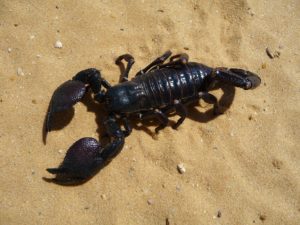Whether you are hiking through lush, green forests or arid and sweltering deserts, I think we can all agree that the wildlife plays an important role in keeping the environment ecosystem balanced.
Though, that also means that humans disrupt this natural balance whenever they are present, as it makes these animals think that a new predator or competitor for their prey has entered the area, when in actuality, you’re likely more interested in taking pictures on the trail than munching on the carcass of a scorpion. (Or are you?)
Desert trails are relatively safe, and if you stick to the path, you are unlikely to have any dangerous encounters with wildlife. Still, some of them are slippery critters, and they may sneak up on you without you even noticing.
This article will examine the animals that are commonly seen in the desert, and how dangerous they can be if approached unprepared. There will likely be some familiar faces from other environments like bees, but there will also be desert-aboding animals like scorpions. Let’s walk ourselves through them.
Scorpions
Ah, of course. When you think of desert animals, nothing comes to mind instantly quite like the scorpion, with its two pincers and its signature tail stinger which it uses to inject its venom with.
There are many, many species of scorpions that exist, but thankfully, only very few types with poison that can actually fatally poison a human.
With that said though, it is probably not worth the risk to hope that you are not unlucky enough to get stung by a scorpion with the fatal venom. You should always be alert of your surroundings. Some scorpions are really tiny and can be hard to notice at first, and it does not help how there are a lot of potential scorpion nests in nearby shaded areas.
Scorpions usually hide in these cool and covered places, so watch your hands and do not touch places that you are not sure is safe just yet.
Rattlesnakes
Are you a snake person? Because if so, then you are in luck. Like scorpions, rattlesnakes are also a common sight, where they populate many deserts thanks to their bodies being finely attuned to surviving the arid environment.
Unlike most scorpions, however, rattlesnakes are venomous, and can be very dangerous, should you get bitten. The venom is rarely fatal to humans, but it is better to not risk it, nonetheless.
Good news, though: Rattlesnakes are more likely to get out of your way then get in. They can sense the vibrations of your footsteps and might see you as a predator and slinker off.
What you simply need to do is watch your step and where you place your hands to ensure that you do not accidentally disturb or corner a rattlesnake and place it on the defensive, as it drastically increases your chances of getting bitten.
Spiders
Deserts host many varieties of spiders as well, which might make the average person squeamish.
Thankfully, like most scorpions, most spiders are not venomous and are just hanging around, doing their own thing.
Tarantulas, for instance, are very hairy and large spider critters, which makes them aggressive, right? Nope, they are surprisingly actually docile and shy spiders. However, they may choose to rear their legs and show their fangs if they feel threatened.
Instead, what you need to watch out for are the more venomous ones, like the black widow spider (can be recognized with its black coat and red hourglass design on its belly) and the brown recluse spider (can be recognized with its brown coloration and its head and back having a violin-like design). Both spiders have potent venom, which can make you very sick and have a small chance to be fatal.
Thankfully, they are not aggressive and seek you out to bite, but they may go on the defensive should they feel cornered and threatened. Make sure you don’t accidentally swipe any spiders
- Mountain Lion
Mountain lions? In the desert? But why? Doesn’t their own name contradict that?
Well, yes, it does. Mountain lions are still primarily located on mountainous areas, but they don’t always stay there. They have been known to wander in even the arid deserts, especially if they are right next to their territories of mountainous regions.
They are unlikely to be a problem for the average hiker as they don’t usually attack and stay away from humans, but the keyword here is “unlikely” meaning that there is still a chance of being attacked.
You don’t want to be part of the unlucky few who got sized up by a mountain lion for an attack. Make sure to make a lot of noise in any way possible and raise your arms to make yourself appear bigger. You want to scare it off.
- Africanized Honeybees
With their alternate title as killer bees, it makes one wonder just how dangerous these tiny things are.
Well, it turns out that their venom is just as potent as a honeybee, which shouldn’t be too much of a problem for most people.
The problem comes from the fact that they are very aggressive when provoked, have a much higher chance to be agitated when approached, and are known to be persistent in chasing away intruders.
It doesn’t exactly help that one of their inherited traits involve farther foraging, especially in desert areas, meaning that their own paths overlapping with desert hiking paths is not exactly unheard of.
If you are unsure of any managed beehives in the area, try not to approach any wild beehives just to be safe. It is hard to tell the difference between a regular domestic bee and an Africanized one.
Conclusion
Most wild animals are dangerous when approached in the desert, but thankfully not fatal. Most of them also prefer to avoid humans.
The best thing you can do is to pay attention to where they might be and do the same to them.

